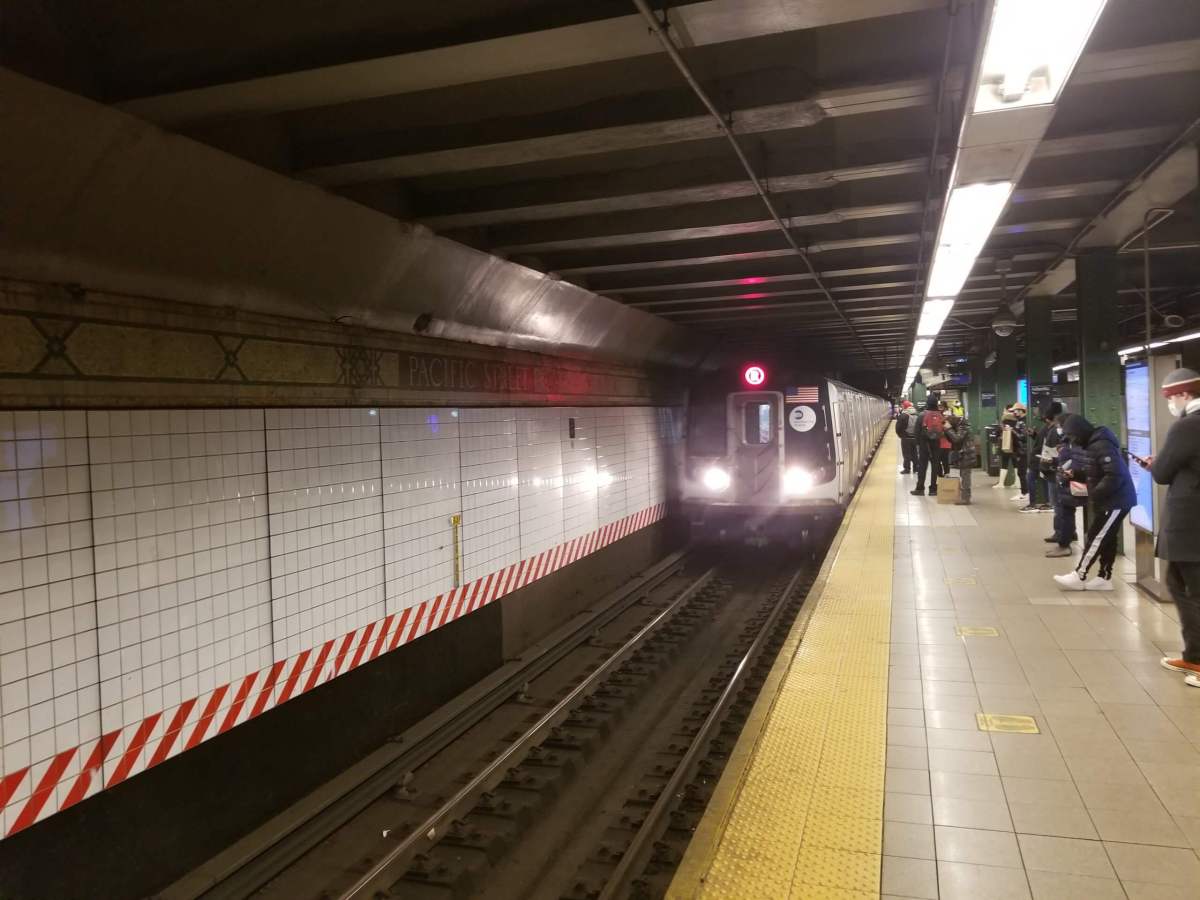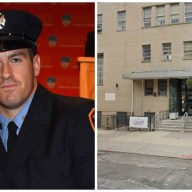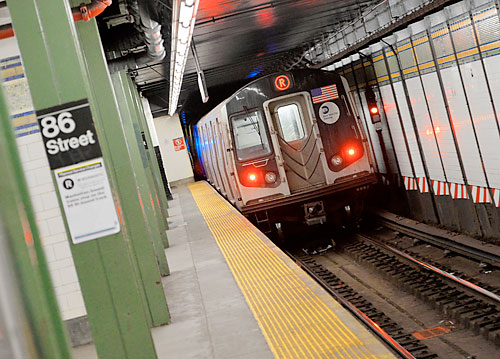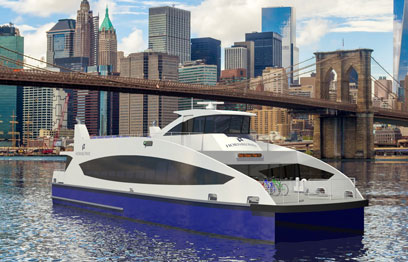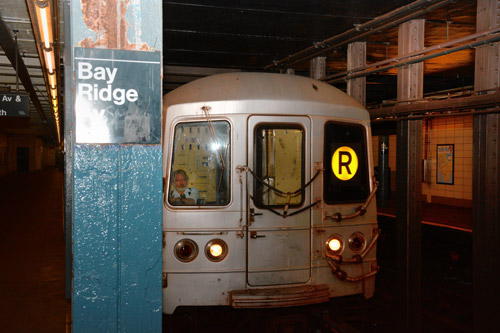The R train is set to see major service disruptions, starting today and trudging for nearly three months.
The subway line is set to undergo major track maintenance work through June. As a result, the R will not run weeknights, from 11:45 pm to 5 am, between 59th and 95 streets in Bay Ridge, to accommodate the track work between Monday, March 28 and Friday, June 17.
To make matters worse, the R will also shut down between 95th and 59th streets on weekends starting next month, from April 16 until June 6.
The N train will still run to 59th Street, and free shuttle buses will make all local R stops in the weeknight and weekend hours between 59th and 95th streets, the MTA says, as well as at 36th Street in Sunset Park.
Seven old switches between 86th and 95th streets will be replaced as part of the work, said MTA Chief of Operations Planning Judy McClain at the MTA Board’s NYC Transit Committee meeting on Monday.
“These switches are at the end of their useful life,” McClain said. “And replacing them will help us improve reliability.”
But for all the pain and turmoil historically inflicted by the R-train upon the residents of Bay Ridge, it’s the only transit option for southwestern Brooklynites to “reliably” (so-to-speak) go to-and-from Downtown Brooklyn, Manhattan, and Queens. And the thousands of essential workers on the night shift who were most impacted by the shutdown of overnight service for a year during the pandemic are once again set to bear the brunt of the impending two-month shutdown of the R.
“We’re happy to see that money is being invested in the future of the system. But it shouldn’t be at the expense of the riders, especially our essential workers and our nurses who work overnight,” said Bay Ridge Councilmember Justin Brannan at a rally at the 86th Street station on Sunday. “Some people might say, who’s riding the train at 1, 2 o’clock in the morning? A lot of people are! We saw that during COVID, a lot of essential workers, they’re not working 9 to 5. When you and I are asleep, the city is still working, and these workers need to get to and from where they’re going safely and reliably.”
Brannan and State Sen. Andrew Gounardes, who also represents Bay Ridge R-train straphangers, along with transit advocates, are asking the MTA to ensure shuttle headways not exceed 8 minutes between buses and that the MTA attempt to time shuttle bus arrivals with subway arrivals at 59th Street to allow for a “seamless” commute.
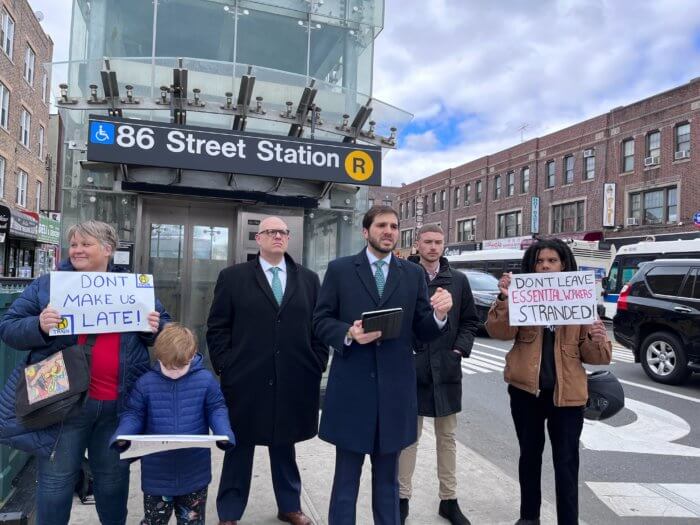
“Commuters should not be waiting on a corner out here in the cold for 20 minutes, 25 minutes for a shuttle bus,” Gounardes said.
McClain said at the board meeting that on weekends, the shuttles will operate every two minutes and on weekday evenings every four minutes, but late at night she said the buses will only operate every 10-20 minutes.
Brannan and Gounardes are also calling for the installation of transit-signal priority — wherein traffic signals are coordinated with buses to minimize time they wait at lights — for shuttle buses making R-train stops along 4th Avenue, which they say would keep the shuttles moving and allow for minimal disruption to Ridgeites’ commute.
Those points were largely echoed by Borough President Antonio Reynoso in an interview with NY1 Monday morning, where he said he’ll also be lobbying the MTA for consistent shuttle service.
“We have folks that are going to hospitals and doing the work to protect us from COVID and so forth,” Reynoso told NY1’s Pat Kiernan. “To have them have to wait too long or not have a consistent schedule is not what we want to do. So I will be talking to the MTA to ensure that’s something that happens. It’s advocacy at this point, I gotta use any influence I have to make sure the folks in Bay Ridge are taken care of off the R train.”
Mixed signals
The MTA’s communication with the public at Bay Ridge subway stations does not make clear how long the shutdowns will be taking place: signage only indicates that work will be taking place on weeknights, some with no timetable, while others only indicate that the weeknight service outages will continue until mid-April.
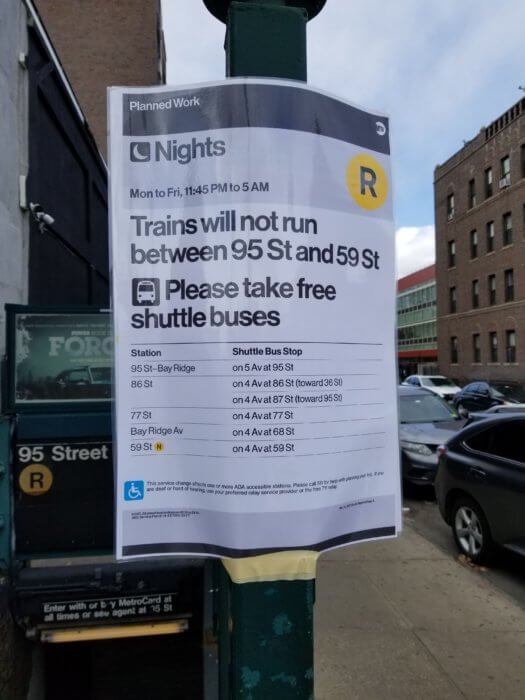
Outside Bay Ridge, at Atlantic Avenue-Barclays Center, signage indicates that the R will not stop overnight at the central Brooklyn transit hub.
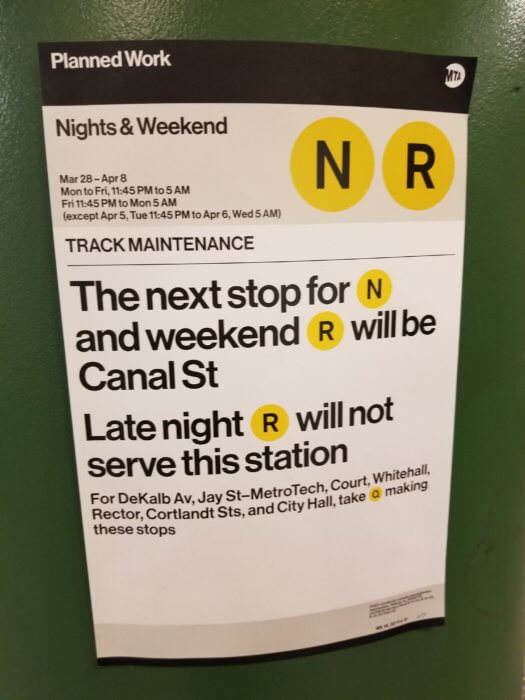
The MTA also only told elected officials that the outages would go until Memorial Day, noting that the weeknight service would be out from 95th Street all the way to Whitehall Street in lower Manhattan, meaning the R would be out of service throughout Brooklyn.
MTA Board member David Jones said that he and other board members had not been informed of the shutdown until today, and that he only found out while watching NY1.
“The board itself wasn’t informed by text or email about this,” Jones said. “So it’s a little upsetting to watch NY1 and watch something rather significant announced that the Board itself was not aware of.”
Online, the MTA’s planned service changes dashboard only has information up until Sunday, April 24; for weeknights, the dashboard says service is suspended between Whitehall and 95th, while starting on April 16, weekend service would be suspended between 36th and 95th.
MTA spokespersons did not respond to requests for comment by press time.
Two years into the pandemic, as city officials seek to remove COVID restrictions and resume life as normal, subway ridership remains a constant reminder of how things have changed. Over 3.2 million people rode the subway on March 24, the latest day when MTA ridership data is available; that’s still just 55.5 percent of the over 5.7 million people that rode on a comparable “pre-pandemic” day, the MTA says.
Any mishaps, conundrums, and bunglings the MTA makes during the R train shutdown, such as the communication breakdown prior to its commencement leaving riders confused, could have rolling impacts on the subway’s recovery, Gounardes said.
“We should be doing everything we can to be making it as easy as possible for people to get back into the subway system and get back into using mass transit,” Gounardes said. “Any obstacles or unnecessary delays that prevent people or deter people from using the system will only set the system back further.”
Additional reporting by Kevin Duggan


